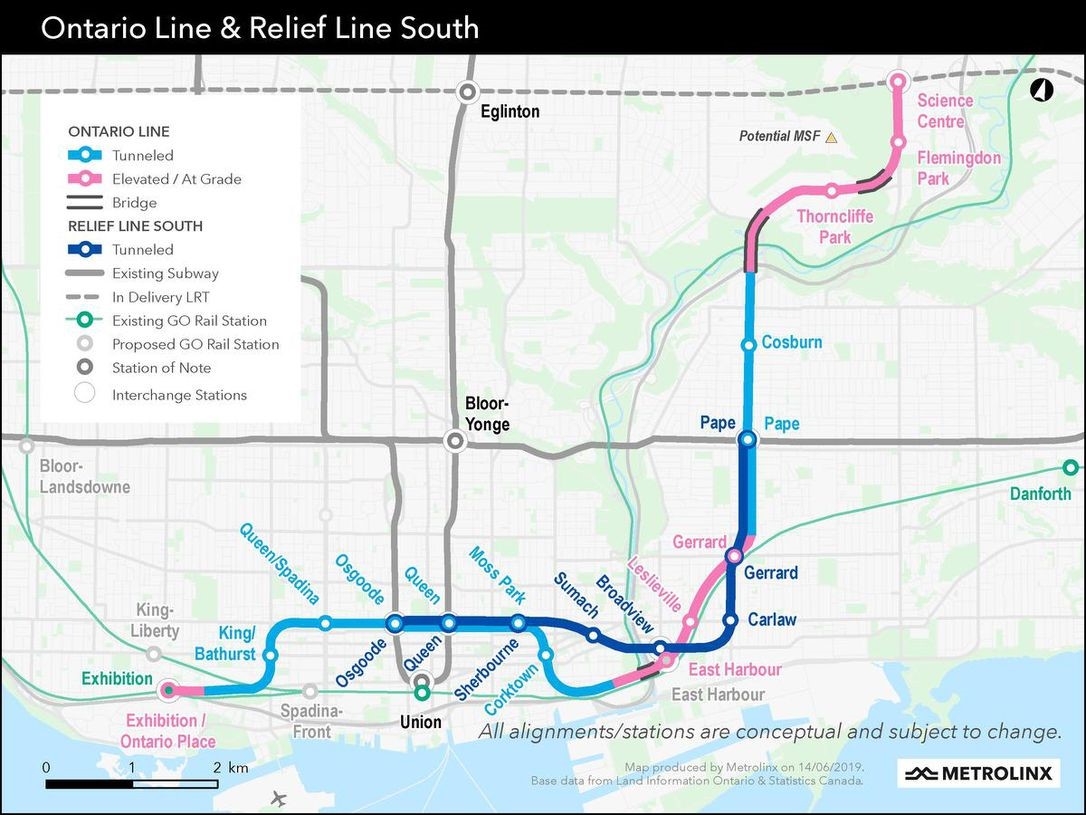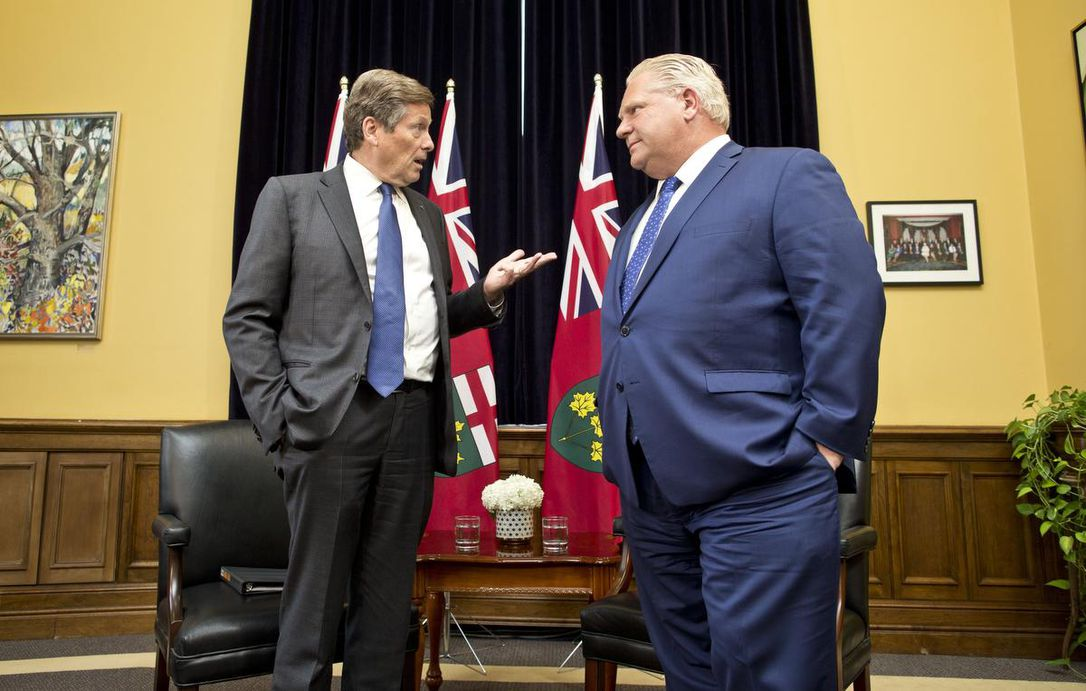Toronto Has a Transit Deal. What’s Next?
The Province of Ontario and the City of Toronto have reached a tentative deal on the future of rail transit within the city limits. The long anticipated council report released on October 16 contains a number of important updates including: confirmation that any further upload of existing subway assets is off the table, the City will support the Province’s four priority expansion projects that include the Ontario Line among others, the City will nominate the Ontario Line and the Scarborough Subway Expansion projects for federal funding, and the City will invest $5.1 to $6 billion to help with the existing $33.5 billion repair backlog in the current subway system.
On top of this deal between the two levels of government, the Federal Liberals have signaled their willingness to approve the funding requests for the projects if re-elected. This comes after a notional commitment from Conservative leader Andrew Scheer to fund projects such as the Ontario Line and the Yonge North Subway Extension.
All in all, the Province and the City have made significant strides to achieving a massive new subway and transit expansion totaling nearly $30 billion – including a real path to co-operation between all three levels of government – which is no small feat. We appear to have an agreement, but what does it all mean and what happens next?

The obvious good news is that all three levels of government are closer than ever to agreeing on a transit plan in Toronto for the first time in recent memory, even though there are major events yet to occur like a federal election result and an impending council vote that makes or breaks the agreed to term sheet.
In addition to that news, the term sheet is an encouraging sign for cleaning up the jurisdictional mess that is transit policy. Cities have long been responsible for partial funding of infrastructure, but with no additional revenue tools that becomes difficult when asking for nearly a third of $28.5 billion worth of projects. As per the original goals of subway upload, the Province owning expansion projects means they can amortize infrastructure costs making these projects more affordable and, for the first time, can really think about the future of regional transit planning.
Moving forward, this agreement can be a model for new major projects in Ontario and Canada. Let the higher level of government lead the way on construction, major planning, transit-oriented development, and getting the project ready for a ribbon cutting. In exchange, the City has an obligation to provide a high level of service, to use the funds generated from the transit system to properly upkeep the new assets, and most importantly to take real financial ownership for neglecting repairs and upkeep over the years.
The repairs on the existing subway assets that the Toronto Transit Commission (TTC) is responsible for total at least $33.5 billion. The term sheet between the City and the Province contains a swap where the City will take its $5.1 billion of previously dedicated transit funds and put it towards the repair backlog or other projects in exchange for formally nominating the Ontario Line and the Scarborough Subway Extension for $4.9 billion of Federal money available under the Investing in Canada Infrastructure Plan.
The repair backlog could be reduced by $5.1 billion, which is a great start. However, that leaves the backlog in the high $20 billion range before any other city projects are considered such as a Waterfront LRT or further expansion of the Eglinton Crosstown East.[2]
[pullquote style=”right” quote=”dark”]This problem of a massive unfunded repair backlog is unresolved, and it will stay that way for a long time.”[/pullquote]To address this, the City does have some funds set aside, but not enough. Therefore, they are obligated under the agreement to report back on funding options in 2020. In addition, the two sides agreed to ask the Federal government for more money when the time comes. This problem was solved in the original upload with the province taking on this backlog and amortizing the cost, but that can only be done if they continued to upload the existing subway system. This problem of a massive unfunded repair backlog is unresolved, and it will stay that way for a long time.
What’s Next and What to Expect:
[pullquote style=”right” quote=”dark”]…it is important to think of the upload as a policy that is in extended hibernation”[/pullquote]To the surprise of most, this agreement should not be looked at as the death of the upload, but rather as a long pause. Per the agreement, the City will be forced to grapple with the question of how to fund the repair backlog by the 2021 budget year. They will have two real options, levy additional taxes on residents or ask for help from other governments. Inevitably, over the next several years the financial benefit of uploading the existing assets will be reconsidered. There may be a very different municipal, provincial, and federal landscape by then, but it is important to think of the upload as a policy that is in extended hibernation.
Second, there are many complicated negotiations to come and questions to be answered. For example, the agreement details that the City will: perform day-to-day operations of the new lines, define operational and maintenance standards in conjunction with the Province, and use the farebox revenue to pay for repairs.[3] What exactly are “day-to-day operations” and who does non day-to-day operations? What are the operational and maintenance standards to be achieved? What happens if those standards are not met, what options does the province have – does it include finding a new entity for day-to-day operations? How does the province set those standards if the city oversees labour agreements? What happens if a train breaks down on the Ontario Line? And the questions go on and on.
These complicated negotiations and questions will inevitably lead to study and perhaps delay, though many of these questions are still unanswered for the well under construction Eglinton Crosstown project. All told, there is a likelihood that the original 2027 in-service commitment for the Ontario Line is not met. That should not be considered a bad thing. After all the original Downtown Relief Line, which traveled substantially less distance than the Ontario Line, was scheduled for 2029 completion despite never being fully funded. Even if the Ontario Line came with full funds but a 2029 in-service date, it is by far and away a win for transit development in the Province and the City.

Toronto Mayor John Tory will likely be painted as the big winner here. To critics of the upload, Tory saved the subway system. To the union that operates the TTC, it’s the much-preferred status quo. All the while, the City will see $28.5 billion of transit money spent. However, the political win will only hold true if Tory can deliver the votes needed to pass the agreement at City council. The province has been clear, this agreement has a firm deadline at the end of October; it is likely not a good idea for the Mayor or City to explore what breaking that deadline means.
Premier Doug Ford has wins and losses coming out of this deal. The Premier has backtracked on another policy area, something that has become a pattern for the Ontario government as of late. This time, the backtrack is on a fundamental campaign promise and related to his biggest priority – transit. This is not reversing a new in-year budget cut and noticeably its not a reversal of a social program. It leaves Ontario political observers with a difficult question, “is there anything the government has promised that is not negotiable?”
On the other hand, the Premier has some big wins. His government has successfully realigned “who does what” in the transit space and ultimately got buy-in on a transit map that looks virtually identical to the one released in Budget 2019. The Premier and his Minister of Transportation Caroline Mulroney have shown they are reasonable, they can work with other levels of government, and that real leadership can lead to real results.
[1] https://www.thestar.com/opinion/editorials/2019/07/25/fords-subway-plan-may-well-mean-more-delay.html
[2] http://app.toronto.ca/tmmis/viewAgendaItemHistory.do?item=2019.EX9.1 This risk is flagged in the city report
[3] Ibid.
[4] https://www.thestar.com/politics/political-opinion/2018/10/22/john-torys-real-opponent-was-never-jennifer-keesmaat-it-was-and-always-will-be-doug-ford.html
